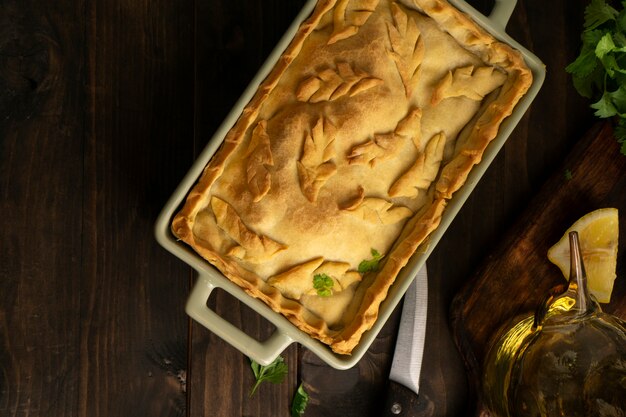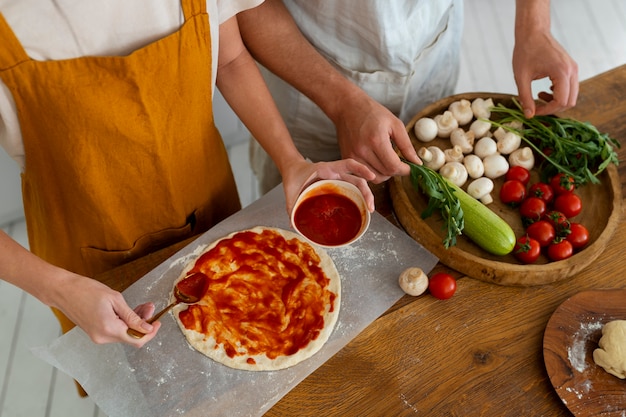(Part 1) The Foundations of Perfect Lasagna: Pre-Cooking

Why Pre-Cooking Makes a World of Difference
Let's be real, nobody wants a lasagna with raw meat or undercooked sauce lurking inside. That's where pre-cooking steps in, ensuring that all the essential components are thoroughly cooked before they even touch the oven. This not only guarantees a safe and delicious meal but also prevents the lasagna from becoming soggy and unevenly cooked. Pre-cooking is the foundation of a truly successful lasagna, and believe me, it's a step you don't want to skip.
My Pre-Cooking Tales: Lessons Learned
I've definitely been there, you know, the cringe-worthy moment when you realize that the meat in your lasagna hasn't been fully cooked. Let's just say it wasn't pretty. Trust me, pre-cooking is a game-changer. I've learned this lesson the hard way, especially after that one time I served lasagna to guests and ended up with a very awkward "I'm so sorry, it's not quite cooked" situation. Luckily, my friends are amazing, but it was a lesson in kitchen humility that I never forgot. Pre-cook, always pre-cook.
(Part 2) The Meat Situation: A Delicious Debate

The Great Meat Debate: Brown or Not Brown?
When it comes to meat in lasagna, there's a classic debate brewing: do you brown the meat first, or just cook it through? Both sides have strong arguments. Personally, I'm a firm believer in browning my meat. It creates an incredible depth of flavor that simply cannot be replicated by just cooking it through. The caramelized bits, the rich aroma, it all adds to the overall experience. But hey, if you're short on time or prefer a simpler approach, just ensure the meat is thoroughly cooked. Nobody wants to deal with a food poisoning scare, right?
My Favourite Meat Options
When choosing the meat for my lasagna, I gravitate towards classic, crowd-pleasing options. Here are my top picks:
- ground beef: The classic choice for a reason! It's versatile, affordable, and a family favourite. You can't go wrong with a good ol' fashioned ground beef lasagna.
- italian sausage: This adds a fiery kick to your lasagna, with a flavour that packs a punch. Just be sure to drain off any excess fat before incorporating it into your sauce.
- Ground Turkey: A lighter option for those watching their calories, but still incredibly delicious. You can even mix it with ground beef for a blend of flavours and textures.
(Part 3) The Sauce Situation: The Heart of Your Lasagna

The Importance of a Stellar Sauce
Let's face it, the sauce is the heart and soul of any lasagna. It needs to be rich, flavourful, and have just the right amount of tang. You're looking for a symphony of tomatoes, herbs, and spices that dance together on your palate. The perfect sauce will elevate your lasagna from good to absolutely incredible.
My Sauce Secrets: Unveiling the Magic
Over the years, I've experimented with countless lasagna sauce recipes, and I've discovered some invaluable secrets. Here are a few of my favorites:
- A Pinch of Sugar: This might seem strange, but a pinch of sugar does wonders to balance out the acidity of the tomatoes, creating a more harmonious flavor profile.
- Fresh Herbs Are Key: Nothing beats the vibrant aroma and taste of fresh herbs. Add a generous amount of fresh basil, oregano, parsley, and thyme, and your lasagna will thank you.
- Don't Fear Spices: Experiment with a dash of cinnamon or nutmeg to add warmth and complexity to your sauce. It might seem unconventional, but it's a game-changer.
(Part 4) The Pasta Situation: The Perfect lasagna noodles
The Right Pasta for a Lasagna Masterpiece
Lasagna noodles are a special breed of pasta, designed to withstand the weight of all those delicious layers without disintegrating. You want noodles that are firm enough to hold their shape, yet thin enough to cook through quickly, ensuring a perfectly cooked and tender bite.
No-Cook Noodles: A Time-Saving Option
For busy cooks, no-cook lasagna noodles are a lifesaver. They're already pre-cooked and ready to be layered into your lasagna. However, I've found that traditional lasagna noodles, the ones you boil before assembling, offer a slightly better texture and a more authentic lasagna experience. Ultimately, it's a matter of personal preference.
(Part 5) The Cheese Situation: A Cheesy Delight
The Mozzarella Dilemma: Choosing the Right Cheese
Now, we're getting to the heart of the matter - the cheese! For lasagna, mozzarella reigns supreme. It melts beautifully, creating those golden, gooey pools of cheesy goodness that are the hallmark of a perfect lasagna. But, the type of mozzarella makes a significant difference.
My Cheese Preferences: A Cheesy Breakdown
Here's my breakdown of the mozzarella options:
- Fresh Mozzarella: This is generally too soft and doesn't melt as well as other types. It's best enjoyed in salads or as a topping for pizzas.
- Low-Moisture Mozzarella: My go-to cheese for lasagna! It's firm, melts beautifully, and holds its shape well, creating the perfect cheesy layer.
- Part-Skim Mozzarella: A good balance between flavour and melt. It's a little less gooey than low-moisture but still delicious and a great alternative if you can't find low-moisture.
(Part 6) Assembling the Lasagna: The Art of Layering
Layer Upon Layer of Deliciousness
Alright, here's the fun part - assembling the lasagna! It's like building a culinary tower of flavour, and the order matters. Start with a layer of sauce, followed by pasta, then more sauce, meat, and finally, a sprinkle of cheese. Repeat these layers until you reach the top, finishing with a generous layer of cheese to create a golden, bubbly crown.
A Quick Tip: The Baking Dish
You'll need a baking dish that's large enough to accommodate all those layers without overflowing. A 9x13-inch baking dish is a good starting point. If you're unsure, it's always better to err on the side of caution and use a larger dish. You want enough space for the lasagna to bake evenly without spilling over the edges.
(Part 7) Baking Time: The Key to Perfection
Oven Temperature and Baking Time: A Balancing Act
Finally, we're ready to bake! Preheat your oven to 375°F (190°C). Baking time is crucial and depends on several factors, including the type of lasagna, the size of your baking dish, and the thickness of your layers. A good rule of thumb is to bake for 30-45 minutes, or until the cheese is bubbly and golden brown.
My Baking Strategy: Achieving Optimal Doneness
To ensure my lasagna is cooked through and the cheese is perfectly melted, I like to cover the dish with foil for the first 30 minutes of baking. This helps the lasagna heat evenly and prevents the cheese from browning too quickly. After 30 minutes, I remove the foil and bake for another 10-15 minutes, or until the cheese is golden brown and bubbly. You can also use a toothpick to check for doneness. It should come out clean when inserted into the center of the lasagna.
(Part 8) Resting Time: Don't Skip This Crucial Step
Let It Rest: A Time for Flavors to Mingle
After your lasagna is out of the oven, resist the urge to dig in immediately. Let it rest for at least 15 minutes before cutting and serving. This allows the lasagna to settle, the flavors to meld, and the cheese to firm up slightly, making it easier to cut and preventing it from being too runny. You'll be amazed at the difference it makes!
Serving Suggestions: Elevate Your Lasagna Experience
Now, you're ready to enjoy your masterpiece! Lasagna pairs beautifully with a crisp green salad, a side of garlic bread, or a simple tomato salad. For a truly indulgent experience, add a dollop of ricotta cheese or a sprinkle of fresh basil on top. And don't forget a glass of chilled red wine to complement the rich flavors of your lasagna.
(Part 9) FAQs: Troubleshooting Your Lasagna Journey
1. My Lasagna is Soggy: What Went Wrong?
Soggy lasagna is a common problem, usually caused by one of two culprits:
- Too Much Sauce: Be careful not to drown your lasagna in sauce. A little goes a long way. Use just enough to create a flavorful, but not soggy, base for your layers.
- Overcooked Pasta: If your lasagna noodles are overcooked, they'll become mushy, leading to a soggy lasagna. Make sure your noodles are cooked al dente (slightly firm to the bite) before assembling your lasagna.
2. My Cheese is Not Melting: Why is My Cheese Not Gooey?
The most likely reason for non-melting cheese is using the wrong type. Low-moisture mozzarella is your best bet for a perfectly melted cheese layer. Also, ensure you're baking your lasagna at the correct temperature. If your oven is too cool, the cheese may not melt properly. If you're using a cheese that's not mozzarella, be sure to check the melting point and baking temperature recommendations.
3. My Lasagna is Too Dry: How Can I Fix It?
If your lasagna is dry, it's likely because you didn't use enough sauce or cheese. You can also add a little bit of broth to your sauce to help keep it moist. Another quick fix is to add a little bit of broth or water to the top of your lasagna before baking, and let it rest for a few minutes after baking.
4. My Lasagna is Not Cooked Through: What Should I Do?
If your lasagna isn't cooked through, it means it needs more time in the oven. Cover it with foil and bake it for another 10-15 minutes, or until the filling is cooked through. You can use a toothpick to check for doneness - it should come out clean. If you're not sure, it's always best to err on the side of caution and bake it for a little longer.
5. Can I Make Lasagna Ahead of Time?
Absolutely! Lasagna is a fantastic make-ahead dish. You can assemble it up to a day in advance and store it in the fridge. When you're ready to bake, simply bring it to room temperature and bake as directed. You can even freeze your lasagna for up to 3 months. Just make sure to thaw it in the fridge overnight before baking.
(Part 10) The Final Word: Embrace the Lasagna Journey
There you have it, my lasagna cooking times guide, packed with tips, tricks, and a whole lot of personal experience. Now, go forth and create your own lasagna masterpiece. And remember, don't be afraid to experiment! The beauty of cooking is that it's a journey of discovery, and with each attempt, you'll learn something new. Enjoy the process, and most importantly, have fun! Bon appétit!
Everyone is watching

Prime Rib Roast Cooking Time Chart: Per Pound Guide
Cooking TipsPrime rib roast. Just the name conjures images of lavish dinners, crackling fires, and hearty laughter. It’s ...

How Long to Bake Potatoes in the Oven (Perfect Every Time)
Cooking TipsBaked potatoes are a staple in my kitchen. They're incredibly versatile, delicious, and surprisingly easy to m...

Perfect Rice Every Time: The Ultimate Guide to Cooking Rice
Cooking TipsAs a self-proclaimed foodie, I've always been a bit obsessed with rice. It's the foundation of countless cuisi...

The Ultimate Guide to Cooking Asparagus: Tips, Techniques, and Recipes
Cooking TipsAsparagus. The mere mention of this spring delicacy conjures up images of vibrant green spears, crisp and burs...

Ultimate Guide to Cooking the Perfect Thanksgiving Turkey
Cooking TipsThanksgiving. Just the word conjures up images of overflowing tables laden with delicious food, the scent of r...
